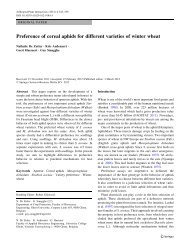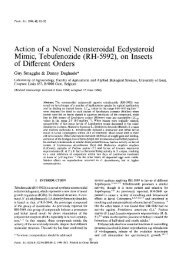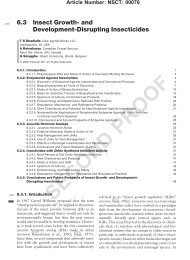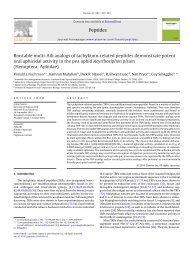RABEA, E.I., BADAWY, M.E.I., STEURBAUT, W ... - Insects.ugent.be
RABEA, E.I., BADAWY, M.E.I., STEURBAUT, W ... - Insects.ugent.be
RABEA, E.I., BADAWY, M.E.I., STEURBAUT, W ... - Insects.ugent.be
Create successful ePaper yourself
Turn your PDF publications into a flip-book with our unique Google optimized e-Paper software.
Comm. Appl. Biol. Sci, Ghent University, 70/4, 2005 823<br />
INSECTICIDAL AND GROWTH INHIBITION EFFECTS<br />
OF CHITOSAN DERIVATIVES CONTAINING AN N-ALKYL<br />
GROUP ON THE COTTON LEAFWORM<br />
SPODOPTERA LITTORALIS<br />
E.I. <strong>RABEA</strong> 1 , M.E.I. <strong>BADAWY</strong> 1 , W. <strong>STEURBAUT</strong> 2 , T.M. ROGGE 3 ,<br />
C.V. STEVENS 3 & G. SMAGGHE 2<br />
1 Department of Pesticide Chemistry, Faculty of Agriculture, Alexandria University, Egypt,<br />
2 Department of Crop Protection; 3 Department of Organic Chemistry; Faculty of Bioscience<br />
Engineering, Ghent University, Coupure links 653, B-9000 Gent, Belgium<br />
E-mail: entsar_ibrahim@yahoo.com<br />
INTRODUCTION<br />
Deacetylation of chitin, the second most abundant biopolymer isolated from<br />
insects, crustaceans such as crab and shrimp as well as from fungi, leads to<br />
poly-(1,4)-D-glucosamine or the so called chitosan with excellent biodegradable<br />
and biocompatible characteristics (Kurita et al., 2000). Chitosan has<br />
<strong>be</strong>come of great interest not only as an underutilized resource, but also as a<br />
new functional material with high potential in various fields. N-alkyl chitosan<br />
derivatives were prepared by introducing alkyl groups into the amine<br />
groups of chitosan (Muzzarelli et al., 1983 and 1990). In this study, a series<br />
of chitosan derivatives containing an alkyl group, N-alkyl chitosan (NAC)<br />
derivatives, were synthesized using a reductive alkylation reaction to examine<br />
their insecticidal and growth inhibition activities against the larvae of<br />
the cotton leafworm Spodoptera littoralis (Boisduval) (Lepidoptera: Noctuidae).<br />
MATERIALS AND METHODS<br />
Materials<br />
Chitosan of low molecular weight (made from crab shells, 85% degree of<br />
deacetylation, DDA) and aldehydes were purchased from Sigma-Aldrich Co.<br />
(Bornem, Belgium). Soy<strong>be</strong>an-wheat germ insect artificial diet was purchased<br />
from Stonefly Ind. (Bryan, TX, USA). NAC derivatives were synthesized according<br />
to Kim et al., (1997). All materials were used without further purification.<br />
Methods<br />
Insecticidal feeding and Growth-inhibitory bioassay against S. littoralis<br />
Third-instar larvae of S. littoralis were selected from a laboratory colony reared<br />
on artificial diet under controlled conditions at 25±2°C, 70±5% RH and a<br />
16h light photoperiod (Smagghe et al., 2001). Chitosan and synthesized derivatives<br />
were tested at 5 g kg -1 in artificial diet, with 30 larvae per product<br />
each. After 7 days of continuous feeding on treated artificial diet, mortality
824<br />
was scored and compared with the control that had <strong>be</strong>en exposed to a diet<br />
treated with solvent only (water and 1% acetic acid in water) (Smagghe et al.,<br />
2000).<br />
The growth inhibitory activity against S. littoralis was measured by a feeding<br />
trial using artificial diet based on larval weight gain through 5 days of feeding<br />
on artificial diet incorporated with the most active compounds with a<br />
growth-inhibitory effect, namely N-(propyl) chitosan, N-(undecanyl) chitosan<br />
and N-(3-phenylpropyl) chitosan. Growth inhibition percentage was calculated<br />
from this equation:<br />
Growth inhibition (%) = [(CL-TL)/CL] x100<br />
Where CL is the larval weight gained in the control and TL is the larval weight<br />
gained in the treatment.<br />
RESULTS AND DISCUSSION<br />
Insecticidal activity of NAC derivatives against S. littoralis<br />
The NAC derivatives had a <strong>be</strong>tter insecticidal activity than chitosan itself<br />
(Table 1). This might <strong>be</strong> explained by the increased lipophilicity of the derivatives<br />
which can lead to improved membrane permeability. The result shows<br />
that the most active compound was N-(3-phenylbutyl) chitosan (17) with<br />
50% mortality, followed by N-(tridecanyl) chitosan (13) and N-(2-phenylethyl)<br />
chitosan (14) with 47% and 37%, respectively. N-pentyl chitosan (2), N-<br />
(ethylbutyl) chitosan (7), N-(2-nonenyl) chitosan (10) and N-(3-phenylpropyl)<br />
chitosan (16) were the moderately active compounds. N-(nonyl) chitosan (9)<br />
was the least active in these derivatives. As exemplified with compounds 2<br />
and 3, branching of the side chains led to a slight decrease in the insecticidal<br />
activity, but the activity was still relatively high. The activity was further<br />
increased when a double bond was introduced in the side chain (compound<br />
9 vs. 10), but overall the activity was still adequate. The exchange of<br />
the hydrogen atom in the long chain with a phenyl ring led to high toxicity<br />
toward larvae of S. littoralis (see compounds 14, 15, 16, 17). In addition, our<br />
results demonstrated that the activity was elevated with an increase of the<br />
chain length. From our results it can <strong>be</strong> concluded that chitosan has low<br />
insecticidal activity against larvae of S. littoralis but chemical modification of<br />
it led to a moderate increase of the activity especially for N-(3-phenylbutyl)<br />
chitosan (17) and N-(tridecanyl) chitosan (13).<br />
In addition, the growth inhibitory activity of N-(propyl) chitosan (1), N-<br />
(undecanyl) chitosan (12) and N-(3-phenyl propyl) chitosan (16) at 5 g kg -1 on<br />
S. littoralis are shown in Table 2. The tested compounds inhibited the larval<br />
growth in a time-dependant manner from the first day of feeding on the treated<br />
diet. As shown in Table 2, the maximum inhibition of growth was observed<br />
on the 4 th day. The development of larvae reared on a treated diet was<br />
shown in Fig. 1. There was a 2-3 fold reduction in weight gain and length in<br />
larvae fed with treated diet. Typically in intoxicated larvae, the normal ecdysis<br />
process was affected with symptoms of inhibition of feeding and weight<br />
gain and the larvae were very small compared to the control. An incomplete<br />
shedding of the old cuticle and the old head capsule covering the new white
Comm. Appl. Biol. Sci, Ghent University, 70/4, 2005 825<br />
capsule were observed. Inhibition of growth and antifeedant effects was observed<br />
(Fig. 1). However, the targets and mechanism of action in insects for<br />
these chitosan derivatives remain unknown so far. As descri<strong>be</strong>d in the literature,<br />
the mechanisms could include repellency, disruption of feeding physiology,<br />
or a chronic toxicity possibly related to the insecticidal action (Ross<br />
and Brown, 1982).<br />
Table 1. Insecticidal activity (%) of NAC derivatives at 5 g kg -1 against third-instar<br />
larvae of S. littoralis by feeding on artificial diet. Data are expressed as mean percentages<br />
± SEM based on 3 replicates per tested compound, n=30.<br />
OH<br />
OH<br />
O<br />
O O<br />
HO<br />
O<br />
NH HO<br />
O<br />
NH<br />
H 2 C<br />
R AC<br />
n<br />
Compound R (DS) Mortality (%)<br />
± SE<br />
1 CH3CH2 0.05 26.7±6.7<br />
2 CH3(CH2)3 0.28 30±5.8<br />
3 CH3CH(CH3)CH2 0.04 20±9.9<br />
4 HOCH2(CH2)3 0.02 10±0.0<br />
5 CH3CH(CH3)(CH2)2 0.17 16.7±3.3<br />
6 cyclohexyl 0.25 16.7±12.0<br />
7 CH3CH(C2H5)CH2 0.15 33.3±3.3<br />
8 CH3(CH2)5 0.23 13.3±8.8<br />
9 CH3(CH2)7 0.04 6.7±6.7<br />
10 CH3(CH2)5CH=CH 0.22 30±15.3<br />
11 CH3(CH2)8 0.22 33.3±3.3<br />
12 CH3(CH2)9 0.06 30±0.0<br />
13 CH3(CH2)11 0.09 46.7±8.8<br />
14 (C6H5)CH2 0.10 36.7±13.3<br />
15 (C6H5)2CH 0.32 33.3±6.7<br />
16 (C6H5)CH2CH2 0.14 33.3±6.7<br />
17 CH3CH(C6H5)CH2 0.37 50±0.0<br />
a Degree of substitution<br />
Table 2. Growth inhibition activity (%) of N-(propyl) chitosan, N-(undecanyl) chitosan<br />
and N-(3-phenylpropyl) chitosan at 5 g kg -1 on S. littoralis during 5 days of feeding on<br />
treated diet. Data are expressed as mean percentages ± SEM based on 3 replicates per<br />
tested compound; n=30.<br />
Compound<br />
Time (day)<br />
1 2 3 4 5<br />
1 57.04±0.02 61.09±0.04 66.75±0.05 75.86±0.04 70.05±0.16<br />
12 51.46±0.004 65.35±0.04 63.67±0.04 65.94±0.02 59.46±0.14<br />
16 44.25±0.02 55.27±0.03 60.41±0.03 64.73±0.04 59.53±0.15
826<br />
450<br />
400<br />
350<br />
Contol<br />
Compound 1<br />
Compound 12<br />
(A)<br />
300<br />
Compound 16<br />
Weight of larvae (mg)<br />
250<br />
200<br />
150<br />
100<br />
50<br />
0<br />
0 1 2 3 4 5<br />
Time (day)<br />
Control<br />
(1)<br />
(12)<br />
Larval length<br />
(mm±SEM )<br />
(26.8±0.10)<br />
(12.4±0.08)<br />
(13.2±0.05)<br />
Figure 1. Development of S. littoralis reared<br />
on artificial diet containing 5 g kg -1 of N-<br />
(propyl) chitosan (1), N-(undecanyl) chitosan<br />
(12) and N-(3-phenylpropyl) chitosan (16). A:<br />
Weight of larvae (mg) of control and treatments<br />
were critically measured on several<br />
days of treatment and data are expressed as<br />
mean percentages ± SEM based on 3 replicates<br />
per tested compound; n=30. B: Photograph<br />
of larvae grown on a diet without<br />
treatment showing normal growth and on a<br />
diet containing 5 g kg -1 of treatments showing<br />
stunted growth.<br />
(16)<br />
(13.8±0.10)<br />
(B)<br />
REFERENCES<br />
KIM C.H., CHO J.W. & CHUN H.J. (1997). Synthesis of chitosan derivatives with quaternary<br />
ammonium salt and their antibacterial activity. Polym Bull 38:387-393.<br />
KURITA K., KOJIMA T., NISHIYAMA Y. & SHIMOJOH M. (2000). Synthesis and some properties<br />
of nonnatural amino polysaccharides: Branched chitin and chitosan. Macromol<br />
33:4711-4716.<br />
MUZZARELLI R., TARSI R., FILLIPINI O., GIOVANETTI E., BIANGINI G. & VARALDO P.E. (1990).<br />
Antimicrob. Agents Chemother. 34:2019-2023.<br />
MUZZARELLI R.A.A., TANFANI F., EMANUELLI M. & MARIOTTI S. (1983). The characterization<br />
of N-methyl, N-ethyl, N-propyl, N-butyl and N-hexyl chitosans, novel film-forming<br />
polymers. J Membrane Sci 18:295-308.
Comm. Appl. Biol. Sci, Ghent University, 70/4, 2005 827<br />
ROSS D.C. & BROWN T.M. (1982). Inhibation of larval growth in Spodoptera frugiperda<br />
by sublethal dietary concentrations of insecticides. J Agric Food Chem 30:193-196.<br />
SMAGGHE G., CARTON B., DECOMBEL L. & TIRRY L. (2001). Significance of absorption,<br />
oxidation, and binding to toxicity of four ecdysone agonists in multi-resistant cotton<br />
leafworm. Arch Insect Biochemistry & Physiology 46:127-139.<br />
SMAGGHE G., MEDINA P., SCHUYESMANS S., TIRRY L. & VINUELA E. (2000). Insecticide<br />
resistant monitoring of tebufenozide for managing Spodoptera exigua (Hübner<br />
[1808]). Bol San Veg Plagas 26:475-481.
828









